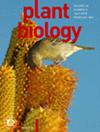在地中海生态系统中,过多的大型野生食草动物种群破坏了植物-传粉者网络。
IF 3.6
3区 生物学
Q1 PLANT SCIENCES
引用次数: 0
摘要
大型食草动物是关键物种,因此它们数量的变化会对生态系统产生级联效应。在过去的几十年里,许多种类的鹿(鹿科)在北半球的许多地区经历了前所未有的密度,可能导致植物-传粉者群落的简化,它们之间的相互作用被破坏,以及生态网络的不稳定。本研究探讨了马鹿(Cervus elaphus)密度增加对植物传粉媒介网络的影响。据我们所知,我们描述了第一个增加密度的大型野生食草动物操纵实验,包括在地中海生态系统中类似的公顷规模的围栏。我们模拟了两种目前鹿群过剩的情景:高密度(>30个体km-2)和高密度(>90个体km-2)。我们将这些情景与相邻的控制圈(没有鹿)进行了比较。鹿的食草性降低了灌木花的丰富度,也降低了开花植物和传粉媒介的丰富度。剩下的植物和传粉者失去了相互作用,一些植物失去了传粉者。随着鹿群密度的增加,由草本植物和专业传粉者形成的模块(紧密联系的物种群)逐渐消失,导致网络专业化和模块化下降。这种简化增加了网络连接和嵌套性。网络稳健性(稳定性的一种衡量标准)保持不变,因为吸引了大多数传粉者的优势植物对鹿来说是不好吃的。结果表明:在鹿群过多的情况下,对植物-传粉媒介网络的影响将随着鹿群密度的增加而增加;(2)植物-传粉者网络将被侵蚀,特别是由美味的、稀有的植物组成,由专业传粉者访问;但(3)优势植物为多面手和难吃植物时,不会影响传粉者网络的稳定性。本文章由计算机程序翻译,如有差异,请以英文原文为准。

Overabundant populations of large wild herbivores disrupt plant–pollinator networks in a Mediterranean ecosystem
求助全文
通过发布文献求助,成功后即可免费获取论文全文。
去求助
来源期刊

Plant Biology
生物-植物科学
CiteScore
8.20
自引率
2.60%
发文量
109
审稿时长
3 months
期刊介绍:
Plant Biology is an international journal of broad scope bringing together the different subdisciplines, such as physiology, molecular biology, cell biology, development, genetics, systematics, ecology, evolution, ecophysiology, plant-microbe interactions, and mycology.
Plant Biology publishes original problem-oriented full-length research papers, short research papers, and review articles. Discussion of hot topics and provocative opinion articles are published under the heading Acute Views. From a multidisciplinary perspective, Plant Biology will provide a platform for publication, information and debate, encompassing all areas which fall within the scope of plant science.
 求助内容:
求助内容: 应助结果提醒方式:
应助结果提醒方式:


